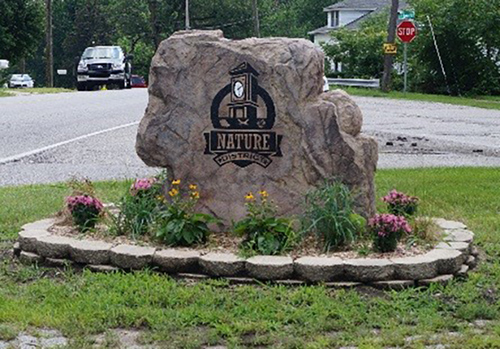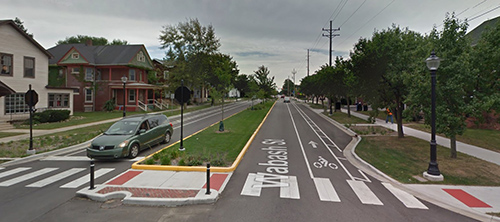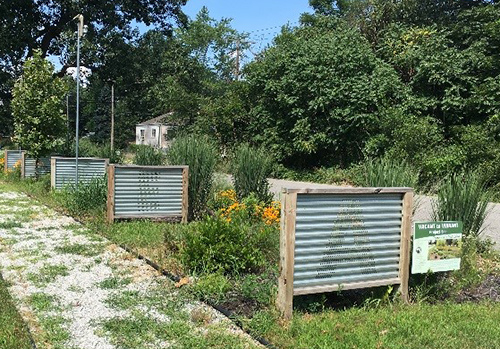Localized Flooding: Policy Tools
- Lake Michigan Coastal Program
- Technical Assistance Planning Program (TAPP)
- Localized Flooding
- Current: Localized Flooding: Policy Tools
Take action
These policy tools can help communities plan and prepare for localized flooding.
- Stormwater/building codes audits and updates
Ensuring that local building codes and ordinances allow green infrastructure and other stormwater management techniques while discouraging building in floodplains is a good start to minimizing localized flooding. A code audit will help identify regulations that prohibit or are silent on the implementation of green infrastructure, open space protection, and low- impact development. Code updates could include on-site infiltration standards, wetland and waterbody protection buffers, and native landscaping standards. View model ordinances below under additional resources.

City of Hobart has designated an area of the city as a Nature District.Advantages
- Low cost.
- Audits met with little public resistance.
- Proactive measures.
Disadvantages
- Depending on the political climate, codes can be difficult to change.
- Code changes could need to be phased in or adapted over time.
Cost
There is little cost associated with updating stormwater and building codes.Additional resources
- Comprehensive planning
Municipal comprehensive plans should be updated every five to 10 years. As a community updates its comprehensive plan, it should incorporate the goals of existing watershed plans and address stormwater management and localized flooding concerns. These concerns can be addressed in comprehensive plans through zoning that promotes infill development, alternative transportation options that reduce demand for streets and impervious surfaces, and No Adverse Impact floodplain management principles.
Advantages
- Adaptable process.
- Holistic process that reflects economic, environmental and societal contributions and impacts.
- Considers a number of approaches/solutions.
Disadvantages
- Time-intensive process.
- Often need outside technical expertise.
Cost
Costs can range from low cost to intermediate costs depending on what resources are already available to the community. For example, if a community wanted to develop a municipal stormwater design standards, they might need to hire a consultant.Additional resources
- Green streets/complete streets
Complete streets, also referred to as green streets, are streets that incorporate green infrastructure and alternative modes of transportation into street planning as a way to decrease impervious surfaces and increase environmental services. Complete streets help to control stormwater by reducing street width, planting trees, adding swales with native plantings, and utilizing permeable pavement. A good way to start a green streets program is to begin with a pilot program with a main thoroughfare. The pilot allows for the program to gain popularity with the public and for any user conflicts to be detected. The pilot can then be expanded to more streets.

Bike lanes, green medians, and native plantings were added during the Michigan City Wabash Street Improvements project.Advantages
- Reduces runoff and pollutant loading.
- Improves street aesthetic.
- Encourages alternative modes of transportation.
Disadvantages
- Time intensive.
- Difficulty in coordinating timing of projects between local government and state agencies.
- May need to be paired with community education.
Cost
Costs are dependent on which features are selected, but generally costs are moderate to high. Features such as permeable pavement and roadway retrofits can be quite expensive, but generally planting trees and native vegetation is not as costly as grey infrastructure.Additional resources
- City of Chicago Complete Streets Design Guidelines
- U.S. EPA Water Quality Scorecard
- U.S. EPA Managing Wet Weather with Green Infrastructure Green Streets
- Green infrastructure best management practices (BMPs)
Green infrastructure best management practices (BMPs) mitigate stormwater runoff through practices that use or mimic natural processes. Green infrastructure BMPs slow down runoff and provide storage and infiltration. Most often these practices look like rain gardens, bioswales, vegetated buffer strips, and open space corridors. Green infrastructure ranges in its storage capacity. Disconnecting a downspout from a residence and connecting it to a rain barrel is a low-cost, low-intensity method that is also accessible for citizens. On the other end of the intensity spectrum are options like stormwater parks and permeable pavements.

Gary’s Aetna neighborhood incorporates public art into stormwater management.Advantages
- Less costly and time-intensive to implement than grey infrastructure.
- Improve the aesthetic of public spaces.
- Improve water quality.
Disadvantages
- Requires coordination between departments.
- Maintenance can be difficult to fund over time.
Cost
Costs associated with implementing green infrastructure can vary depending on what the community chooses to do. For example, updating local guidelines to encourage residential rain gardens has virtually no cost, whereas installing a municipal bioswale could cost between several hundred to thousands of dollars. Installing a rain barrel generally costs less than a hundred dollars but retrofitting a road with permeable asphalt is expensive. All of the costs associated with implementing green infrastructure should be compared with the savings in managing stormwater runoff and the alternative grey infrastructure solutions.Additional resources
- CRS policy tools and insurance discounts
The Community Rating System (CRS) is a program administered by the Federal Emergency Management Agency (FEMA). It recognizes communities that go above and beyond the minimum floodplain management requirements by offering reduced flood insurance premiums in the community. To participate in CRS, a community must do some combination of the 19 creditable activities. These activities fall under the categories of Public Information, Mapping and Regulations, Flood Damage Reduction, and Flood Preparedness. Based on the amount of credits earned, property owners are eligible for a discount of between 5 and 45 percent.
Advantages
- Discounted flood insurance for community members.
- Many communities already doing some of the activities.
- Flexibility in meeting community needs and goals.
Disadvantages
- Creditable activities may not be applicable or feasible for all communities.
- Multiple activities are required to earn an insurance discount.
Cost
The cost varies depending on which activities and policies a community adopts and the resources available.Additional resources
- Stormwater fee discounts for BMP implementation
Incentivizing private and commercial property owners to adopt green infrastructure best management practices (BMPs) is one way to expand green infrastructure beyond lands in public ownership and reduce the burden on public stormwater management infrastructure. One way to do this and get more properties managing stormwater is to offer a discounted stormwater utility fee for BMP implementation. Common eligible BMPs include rain garden installation, use of permeable pavement, and rainwater harvesting. To determine a discount schedule, a community should look at the utility revenue and what their projected reduced burden will be. The BMPs, to varying degrees, should offset the loss of revenue from the discounted utility fees.
Advantages
- Private property contributes to stormwater management.
- Not a regulation, so property owners can choose whether or not to participate.
Disadvantages
- Stormwater utilities are typically underfunded, so discounts may not be feasible.
- Resource-intensive to set up rate structure and verify BMP functionality.
Cost
The cost of implementation is dependent on current stormwater utility fees, if any, and the discounts offered. Program administration must be factored in, too. A consultant may be needed to set up the program.Additional resources
- Development Incentives for Low Impact Development and Best Management Practices
Low Impact Development (LID) refers to strategies that emphasize conservation and management of stormwater runoff on-site. Development incentives for LID and best management practices (BMPs) are a good way to incorporate stormwater management into new development and retrofits. These incentives can take many forms such as a credit against open space requirements, subsidies or tax abatements in exchange for LID and BMP implementation, and expedited permitting and review processes. Common eligible activities include incorporating sustainable site design features, green infrastructure such as green roofs or rain gardens, and stormwater management features that double as public recreational spaces.
Advantages
- Relieve stress on public infrastructure.
- Improve water quality.
- Can improve aesthetic of developments.
Disadvantages
- May be resource-intensive to set up incentive program.
- May place extra pressure on staff to review development plans quickly.
- May not have large impact on stormwater management because only applies to new or redevelopment and is voluntary.
Cost
The cost of development incentives are dependent on which incentives are chosen. For example, if a community decides to reduce fees for developers that incorporate stormwater management into their development, then the cost would be the difference between the reduction in revenue from the reduced fee and the savings from the reduced stormwater management burden. In another example, if a community decided to offer an expedited development review period for projects implementing LID and/or BMPs, then the cost of the incentive would be low.Additional resources
- Grants, Rebates and Installation Financing for Retrofits
Grants are attractive funding options for small-scale or pilot projects. Grant programs are administered through philanthropic organizations, nonprofits, and federal and state government. Another form of financing for retrofits and development is rebates and installation financing. These mechanisms provide incentives for property owners to install green infrastructure on their properties. They often target areas that have demonstrated the greatest need for green infrastructure through excessive runoff and flooding. Rain barrel distribution is a common example of this policy tool. If a community is planning a larger project, they could also consider low interest loans. The State Revolving Fund (SRF) Loan Program provides low-interest loans to Indiana communities for projects that improve water infrastructure and flood control.
Advantages
- Good for pilot projects.
- Creates incentives to implement BMPs.
- Opportunities to leverage limited resources.
Disadvantages
- Grants and SRF loans are competitive.
- Grant funding is not reliable.
- Revenue is required; grants often require match funding and loans must be repaid over time.
Cost
The cost associated with grants, rebates and loans are dependent upon the size of the project. Generally, the cost will be less than doing nothing or administering the program without using these funding options.Additional resources
- IDNR Coastal Program Grant Referral Service
- Indiana Department of Homeland Security Mitigation Grant Program
- Indiana Finance Authority State Revolving Loan Fund: Flood Control
- U.S. EPA Managing Wet Weather with Green Infrastructure Municipal Handbook: Funding Options
- U.S. EPA Managing Wet Weather with Green Infrastructure Municipal Handbook: Incentive Mechanisms
- Awards and recognition programs
Awards and recognition programs highlight successful examples of green infrastructure as a means of stormwater management and flood mitigation in a community. Winners can be businesses, government agencies, schools, property owners, community organizations and non-profits. These awards can be good opportunities to receive press coverage and share information about effective programs with other groups.
Advantages
- Raise awareness about stormwater and floodplain management.
- Recognize exceptional organizations and individuals.
- Create an incentive for groups to improve projects.
Disadvantages
- Low impact on stormwater management.
Cost
Awards and recognition have little to no cost associated with them.Additional resources
